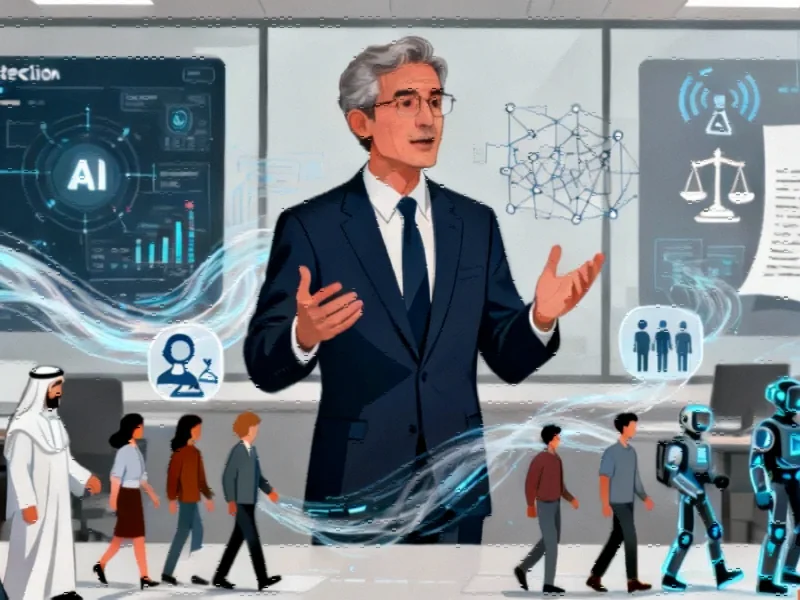The Inevitable Shift: AI’s Impact on Employment
JPMorgan Chase CEO Jamie Dimon has issued a sobering assessment of artificial intelligence’s impact on the workforce, telling skeptics that denying massive job displacement is akin to “sticking their head in the sand.” In a candid conversation with Fortune Editor-in-chief Alyson Shontell, Dimon drew historical parallels to previous technological revolutions while emphasizing the unprecedented scale of AI’s transformative power.
“It will eliminate jobs,” Dimon stated unequivocally. “I think people should stop sticking their head in the sand. So did tractors and so did cars.” His comments highlight what many economists have been warning about for years – that AI represents not just another technological advancement, but a fundamental restructuring of how work is organized and valued across virtually every sector.
The Social Contract: Addressing Economic Displacement
Dimon emphasized that the conversation must move beyond whether jobs will be lost to how society will manage the transition. “You can’t just take all these people and throw them on the street where the next job is, you know, making $30,000 a year when they were making $150,000,” he warned. “You’ll have a revolution.” This stark assessment underscores the potential social consequences of rapid technological change without adequate safety nets.
The banking executive outlined several potential solutions, including upskilling workers for new AI-based tech jobs, providing income assistance, facilitating early retirement, and implementing major retraining initiatives. These measures reflect growing recognition among business leaders that technological advancement cannot be separated from its social implications, particularly as industry leaders confront workforce transformation on an unprecedented scale.
JPMorgan’s AI Implementation: A Case Study
Dimon revealed that JPMorgan has invested approximately $2 billion in AI technologies, deploying machine learning systems for fraud detection, behavioral pattern analysis, legal document review, regulatory compliance, and business process optimization. The bank has developed its own internal AI models that have significantly improved operational efficiency, though Dimon acknowledged the difficulty in quantifying the exact value of time savings at this early stage.
“Underlying the [AI] hype is a real technology that is extremely transformative and powerful,” Dimon noted, emphasizing that businesses cannot afford to wait on the sidelines. The bank’s executives have actively engaged with the technology, learning techniques for document processing, pattern recognition in fraud detection, and database correlation that represent just the beginning of AI’s potential applications.
Broader Technological Context
The conversation about AI’s impact occurs alongside other significant industry developments that are reshaping the economic landscape. From supply chain innovations to tariff strategies, businesses are navigating multiple simultaneous transformations that require careful strategic planning and adaptation.
Meanwhile, surveillance technologies continue to evolve rapidly, with new partnerships emerging that could have significant implications for privacy and security frameworks. The recent technology partnerships between private companies and law enforcement agencies demonstrate how AI-adjacent technologies are already transforming traditional institutions and practices.
Regulatory and Legal Considerations
Dimon stressed the importance of establishing proper regulations and guardrails as AI adoption accelerates. This call for responsible implementation comes amid growing legal scrutiny of technology’s role in society, as evidenced by the intensifying legal battles surrounding technology policy and implementation.
The entertainment and media sectors are also experiencing significant disruption, with major content distribution deals reflecting how traditional business models are being reshaped by digital transformation. Recent market trends in media rights and broadcasting illustrate the broader pattern of industry disruption that AI is accelerating across multiple sectors.
Embracing the Transformation
Despite the challenges, Dimon remains bullish on AI’s long-term potential. “So, use it. Get good at it,” he advised business leaders and workers alike. “Make it part of your tool set and your weapon set.” His comments reflect a pragmatic approach to technological change – acknowledging the disruption while emphasizing the importance of adaptation and mastery.
As with previous technological revolutions, from mechanized agriculture to automotive transportation, the initial displacement creates both challenges and opportunities. The critical difference with AI, according to Dimon and other experts, is the speed and scale of transformation, requiring coordinated responses from business, government, and educational institutions to ensure the benefits are widely shared while mitigating the social costs of transition.
This article aggregates information from publicly available sources. All trademarks and copyrights belong to their respective owners.
Note: Featured image is for illustrative purposes only and does not represent any specific product, service, or entity mentioned in this article.



